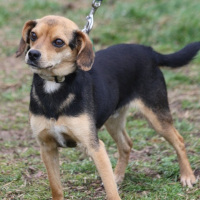Appearance of the Cheagle
|
| Cheagles have a shiny, straight, short coat, which can have different colors, depending on the contribution of their parents. Although they can have solid colors (usually white or cream), their coat is usually a combination of more than one color: white, black, cream, brown, bronze. Some Cheagles have freckles that resemble those of the Beagle. Cheagles have a long, curly tail, overbite, Chihuahua paws and muzzle, and Beagle tail, ears and head. Cheagles are compact and small like the Chihuahua, but appear rougher, resembling the Beagle. Cheagles weigh no more than 9 kilos and measure 23 to 36 centimeters at the withers, males being slightly taller and heavier than females. |
Temperament of the Cheagle
|
| Cheagles are pets and serve no other purpose, despite the hunting heritage of their Beagle parent. Cheagles are extraordinary companions, as they are very friendly and open, playful and loving towards their families, to whom they are eternally loyal and protective. In return, they demand a lot of attention and don't stay alone for long. They love to play games and run around, entertaining adults and children alike. Although they get on well with children, it's best not to leave them unsupervised with young children, as a certain level of awareness regarding dog handling is required to interact with this crossbreed. Pushing more towards the Chihuaha side, Cheagles are very energetic and fearless. Because of their high alertness and tendency to bark, they are good watchdogs. They are easily excited and, when happy, tend to bark in a high-pitched voice, leap energetically and jump enthusiastically. Cheagles can be aggressive towards other dogs, displaying nipping and biting behaviors. Early socialization and appropriate training are therefore essential. This aggression is generally associated with Small Dog Syndrome, a behavioral problem often linked to overprotection on the part of the owner, leading to poor social and behavioral skills in the dog. The Beagle's Cheagle side softens their personality by adding a calmer, gentler nature. The Beagle's kindness and gentleness dampen the Chihuahua's energy. As a result, the Cheagle proves to be a good mix of active and large dog, who likes to run but also snuggle, is open and affectionate, and is an excellent choice for families with older children, people living in apartments and single people. However, due to their high energy levels, they can be difficult to train and are therefore not the best choice for first-time dog owners. |
Needs and activities of the Cheagle
|
| Activity requirements for Cheagles are relatively straightforward, and they are usually satisfied with forty to sixty minutes of vigorous activity a day. It's often best to divide these sessions into smaller chunks of time. These little dogs are very happy living in smaller spaces with a few short walks or energetic indoor play sessions a day, and many can also excel at scent-hunting activities. Although they can sometimes become yappy, this breed combination is much less vocal than the average Beagle, making them more suited to apartment living than many other Beagle hybrids. |
Maintenance of the Cheagle
|
| Most Cheagles require very little grooming to keep them clean and healthy. Baths should be administered sparingly to these dogs, as they are likely to develop dry, flaky or irritated skin if bathed too often, but regular brushing should be carried out to remove dead hairs and distribute their natural oils correctly. Two to four brushings a week are usually enough to keep short- and long-haired varieties healthy, clean and shiny, although long-haired dogs may need a little more detangling and a little more time. It's important to keep the ears clean and dry, as hanging ears are more prone to infection. |









 English (United Kingdom)
English (United Kingdom)